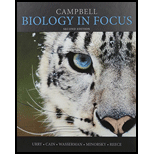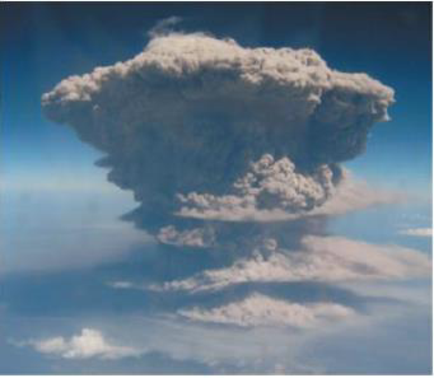
Concept explainers
SYNTHESIZE YOUR KNOWLEDGE

In 2010, the Soufriere Hills volcano on the Caribbean island of Montserrat erupted violently, spewing huge clouds of ash and gases into the sky. Explain how the volcanic eruptions at the end of the Permian period and the formation of Pangaea, both of which occurred about 252 million years ago, set in motion events that altered evolutionary history.
Want to see the full answer?
Check out a sample textbook solution
Chapter 23 Solutions
Campbell Biology in Focus; Modified Mastering Biology with Pearson eText -- ValuePack Access Card -- for Campbell Biology in Focus (2nd Edition)
Additional Science Textbook Solutions
Human Biology: Concepts and Current Issues
Genetic Analysis: An Integrated Approach (3rd Edition)
Laboratory Experiments in Microbiology (12th Edition) (What's New in Microbiology)
Genetic Analysis: An Integrated Approach (2nd Edition)
- In the early nineteenth century, the French scientist Georges Cuvier provided conclusive evidence of the extinction of species on Earth. Although Cuvier correctly asserted that a series of catastrophes led to these extinctions, he could not provide a testable explanation of the source of the new animals and plants that appeared after the extinction of older forms. How would you argue that modern evolutionary theory provides an explanation for the proliferation of new forms of life after mass extinctions?arrow_forwardhttps://youtu.be/SkeNMoDlHUU?si=AwIDdGlbpS69KBVe (Summarize it in a bullet form and send the answer here based on the given questions) Here are the following questions: 1. Discuss the major events in the history of life on earth, starting from the origin of life up to the present day, highlighting key evolutionary developments and transitions. 2. What is the role of mass extinctions in shaping the history of life on Earth? How do these events influenced biodiversity and evolutionary trajectories?arrow_forward1) Does the fossil record indicate that life first appeared in the water or on the land? WATER or LAND 2) Does the fossil record indicate that invertebrates (trilobites) and vertebrates (fish) evolved during the same geological period? YES or NO 3) Does the fossil record indicate that birds evolved from mammals or reptiles? MAMMALS or REPTILES 4) The fossil record indicates that hominids evolved from an ancestral hominoid approximately? 4-5 million years ago or 1-2 million years ago What kinds of organisms appear earliest in the fossil record? PROKARYOTES or EUKARYOTESarrow_forward
- We live in the Cenozoic era, and scientists know more about this era and the epochs it’s divided into than any other time period. Why is this? A. We know more about the Cenozoic era because this is the only era that has had a wide diversity of species living on Earth. B. We know more about the Cenozoic era because this is the most recent time period in the history of the Earth, and we have more information available to study. C. We know more about the Cenozoic era because the planet’s poles reversed magnetic fields at the beginning of this era. D. We know more about the Cenozoic era because fossils don’t exist to document previous eras.arrow_forwardThe great apes made their first appearance in the fossil record between 23 and 2.6 MYA, which: represents the starting and ending dates for the Paleogene Period represents the starting and ending dates for the Cretaceous Period represents the starting and ending dates for the Jurassic Period represents the starting and ending dates for the Neogene Period represents the starting and ending dates for the Triassic Periodarrow_forwardIdentify each of the following as an example of MICROEVOLUTION or MACROEVOLUTION.Then,state whether it supports the theory of gradualism or punctured equilibrium.(a) The Cambrian explosion(a period of rapid evolutionary change where many complex organisms evolved).(b)The evolutionary change of animals and terrestrial plants.(c)beetles with a GREEN sheen are more prevalent than beetles with a BLACK sheen.arrow_forward
- 9) Rocks containing fossil evidence have been found in Canada suggesting how life on Earth evolved. What about the rocks led to this belief? A) They contained graphite, a from of pure carbon. B) They contained fossil evidence of human remains. C) They were metamorphic rocks with traces of water. D) They were extrusive rocks that came from the volcanic vents. Not Gradedarrow_forwardPart 1: Use this image to describe the relationship between H, F. and D, including how closely they are related to each other, and determine the most recent common ancestor for these species. Part 2: Using the above image, estimate how long ago the common ancestor for H, F, and D lived. Part 3: Of species H, F, and D, which have gone extinct without producing any evolutionary descendants? Provide evidence to support your answer.arrow_forwardPlace the following events in the order in which they are thought to have occurred in early evolution of life. the ability to produce proteins from genetic material the ability to use O2 as an electron acceptor for producing cellular energy the formation of heritable information (RNA) the ability to use light energy to fix CO2arrow_forward
- How does finding the same fossils of a land animal on two different continents support the hypothesis of continental drift? A) The land animal fossil is now found in colder parts of the world which means the continents had drifted since the fossils were made. B) The land animal fossil could only have ended up fossilized on both continents if they were once together C) The land animal fossil was unable to swim across oceans so the fact that its fossils were found on distant continents suggested those continents had once been fused together as later moved apart. D) The land animal fossil wasnt found in Asia which wegner thought was only stable continent that hadn’t moved.arrow_forwardScientists are examining the possible role of a large asteroid in the cretaceous mass extinction event. A large asteroid strike would likely have caused rapid climate cooling and the diffusion of sunlight. which of the following statements are the best null and alternative hypotheses when scientists look at the geologic evidence of extinction related to the asteroid strike?arrow_forwardWhat characteristic(s) of the fossil record make(s) it strong support of evolution? a) It has fossils of many species in it that are not found on earth today. b) It is has a complete record of every form of life ever existing c) Species appear in sediment layers in a consistent pattern d) All fossils are similar to living forms found in the same area as the fossils Group of answer choices A. b and d B. a and b C. c and d D. a and c E. b and carrow_forward
